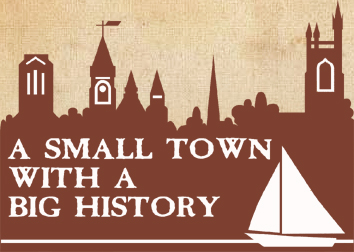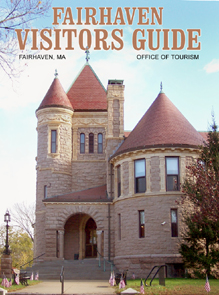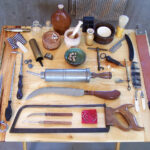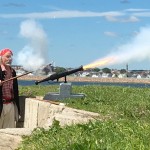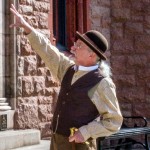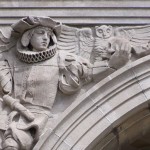(1607-1695)
Fairhaven’s own Pilgrim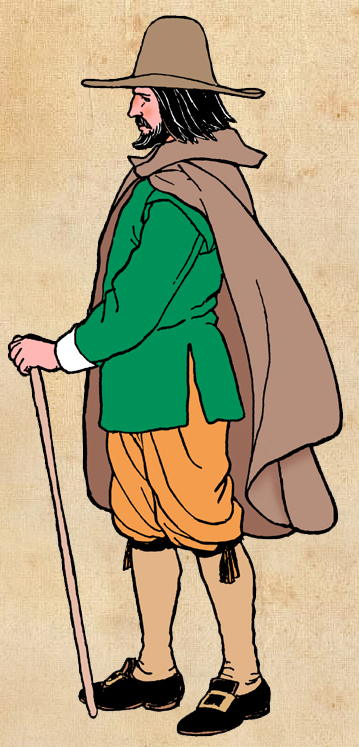
John Cooke, the oldest child of Francis and Hester (Mahieu) Cooke, was baptized in Leyden, Holland, between January 1 and March 31, 1607. In July, 1620, John Cooke and his father sailed from Leyden on the Speedwell, the smaller of two ships bound for America. When the Speedwell sprung a leak and was deemed unseaworthy, the Cookes were transferred to the larger ship, Mayflower. John Cooke’s mother Hester and the other children arrived in Plymouth in 1623 on the Anne.
Also arriving on the Anne were Elizabeth Warren, the wife of Mayflower passenger Richard Warren, and her children, including Sarah. On March 28, 1634, John Cooke married Sarah Warren.
At Plymouth, Cooke represented the town to the Colony Court and was a deacon in the church, though he was later excommunicated, most likely for supporting Quaker and Baptist causes. Cooke’s break with the established church probably influenced his decision to leave Plymouth.
Cooke was one of the 36 people who purchased the Old Dartmouth territory in 1652. He move here about ten years later, following his son-in-law Arthur Hathaway and others. Also settling here about that time was Cooke’s cousin Lt. Jonathan Delano.
Cooke’s homestead was located in the northern part of present-day Fairhaven, between Riverside Cemetery and Woodside Cemetery, with his house overlooking the Acushnet River from the crest of the hill near the intersection of Adams Street and Howland Road. Between his home and the river, he built a garrison, as a defense when relations with the Native people deteriorated in the 1670s. The site of Cooke’s garrison is marked with a plaque in a small lot on the north side of Howland Road between Main and Sycamore streets.
Cooke was one of the most prominent men during the early days of Dartmouth, which was incorporated in June, 1664. In 1667, he was authorized to perform legal duties, such as solemnizing marriages, issuing warrants and administering oaths. He was appointed twelve times as Representative to the Court at Plymouth between 1666 and 1686 and also served as a selectman nine times between 1670 and 1683, with consecutive years broken only by the abandonment of the town during the King Philip War (1675-1678).
Cooke’s already large land holdings (he owned 3 of the 34 shares) were added to by purchase or grant. In 1666, he bought “Howard’s Neck” in Acushnet from Joseph Russell. In 1668, he and son-in-law Daniel Wilcox obtained a license to operate a ferry across the Seconnet River between Portsmouth and Tiverton and Cooke purchased land there. Cooke owned West Island, which he bought from Wampanoag leader Metacomet for £10. In 1672, the town gave Cooke Popes Island, then known as Ram Island, as payment for services. He also owned property called “Freemans Meadows” in Rochester.
Cooke, having become affiliated with Baptist preacher Obadiah Holmes, is said to have been the first Baptist minister in Dartmouth. He is credited with organizing a Baptist society in what’s now Tiverton, RI, about 1680.
The first bequest in John Cooke’s will, dated November 9, 1694, is to daughter Sarah and son-in-law Arthur Hathaway—Acushnet land that Cooke had bought from John Russell “in the point at or near the Burying place in Dartmouth.” This land remained in the Hathaway family until the 1830s.
John Cooke died November 23, 1695, at the age of 88, the last male Mayflower passenger. Cooke was survived by four of his five daughters and by his wife Sarah, who was alive until at least December 7, 1696, when she presented the inventory of her husband’s estate.
DESCENDANTS OF JOHN COOKE
Since John Cooke had no sons to carry on his family name, his descendants bear the married names of his five daughters:
• Sarah Cooke married Arthur Hathaway on November 20, 1652, in Plymouth. Their children were John, Sarah, Hannah, Lydia, Mary, Thomas and Jonathan.
• Elizabeth Cooke became the second wife of Daniel Wilcox on November 28, 1661, in Plymouth. Wilcox’s first two children, Daniel Jr. and Samuel, are attributed to his first wife, whose name is unknown. Children attributed to Elizabeth Cooke and Daniel Wilcox are Mary, Sarah, Stephen, John, Edward, Thomas, Lydia and Susanna.
• Hester Cooke married Capt. Thomas Taber ca. 1667. Their children were Thomas Jr. and Esther. Shortly after the birth of Esther, Hester died. Taber then married Mary Tomson, a daughter of John Cooke’s sister Mary, ca. 1673. Remains of the chimney wall of Thomas Taber’s house, built ca. 1678, still stand in Fairhaven.
• Mary Cooke married Philip Taber, brother of Capt. Thomas Taber, ca. 1668. Their children were Mary, Sarah, Lydia, Philip, Abigail, Esther, John and Bethia. Following the death of her husband ca. 1692/3, Mary married ——— Davis.
• Mercy Cooke married Stephen West ca. 1683. Their children were Katharine, Sarah, Ann, Bartholomew, Amy (or Almy), Steven (or Stephen), John, Eunice and Lois. Bartholomew West lived on the old Cooke homestead during the Revolution and his house was burned by the British in September 1778. At that time the family Bible was stolen and today it is on display in England.
DEATH DATES & BURIAL PLACES
The death date of John Cooke, November 23, 1695, and that of his daughter Mercy (Cooke) West, November 22, 1733, are the only ones of the immediate family that are documented. There are no known burial records of any immediate members of the family.
The John Cooke Memorial in a public park on Pilgrim Avenue in Fairhaven was installed by the Fairhaven Improvement Association in 1903. There is no primary-source historical evidence to support a traditional claim that John Cooke was buried in that location. There is a strong possibility that Cooke’s former son-in-law Thomas Taber was buried in that vicinity.
Additional information can be found at John Cooke: Fairhaven’s Pilgrim
Click on the links below to learn about Fairhaven sites associated with John Cooke.
